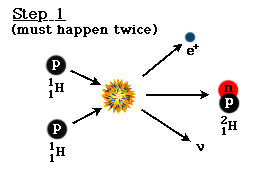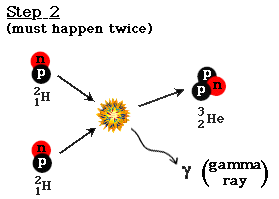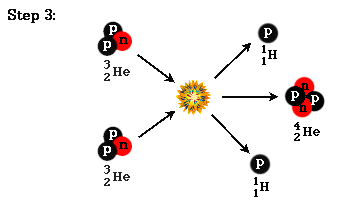Proton-Proton Chain
(NOTE: It is important to remember that not all collisions result in a reaction taking place. If the energies and/or orientation of the particles aren't correct/sufficient, the particles will simply behave like marbles bouncing off each other. The percentage of successful collisions is actually very small.)
This process dominates in stars where the core temperature is less than 15,000,000 K (such as our sun). It consists of three reactions that result in the conversion of six protons into a He nucleus plus two residual protons. An important reaction in this process is that of "proton conversion." In this reaction, a proton is converted into a neutron. The positive charge and some excess energy is released through the emission of a positron (a positive electron) and a neutrino.

The first step in this process is the collision of two protons where proximity permits the strong nuclear force to bind them together. The resulting combination is not stable, and one of the protons will decay to become a neutron, and this forms a stable nucleus of deuterium. This step needs to occur twice.

The second step involves the collision of a deuterium nuclei (produced in Step 1) with a proton to form a nucleus of Helium-3. The increased stability results in the release of some energy in the form of a gamma ray. This step must also occur twice.

The final step is the collision of two Helium-3 nuclei to form a Helium-4 nucleus. In this step, two protons are released that continue to participate in Step 1 or Step 2.




